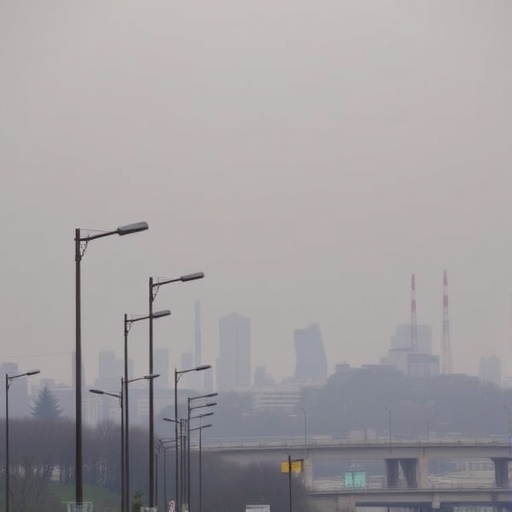
In a groundbreaking study published in the American Journal of Respiratory and Critical Care Medicine on August 29, 2025, researchers from Harvard T.H. Chan School of Public Health have unveiled new insights into the complex relationship between air pollution and asthma hospitalizations. Their work shines a critical light on the specific compounds within fine particulate matter (PM2.5) that most significantly exacerbate asthma, challenging previous assumptions and paving the way for more precise pollution control strategies.
For decades, scientists have known that exposure to PM2.5 – particulate matter smaller than 2.5 micrometers in diameter – is linked to a variety of respiratory ailments, including asthma attacks that require hospitalization. However, PM2.5 is not a uniform entity; it’s a heterogeneous mixture of metals, organic compounds, and other chemical constituents. Prior research has largely focused on the impact of total PM2.5 mass or individual pollutants in isolation, leaving a crucial gap in understanding which specific components within PM2.5 wield the most influence over asthma outcomes.
To address this challenge, the Harvard team, led by environmental epidemiologist Joel Schwartz, employed an innovative methodological approach that bridges the gap between isolated pollutants and overall particulate matter exposure. They deployed advanced machine learning algorithms to dissect the intricate composition of PM2.5, identifying a comprehensive panel of compounds including bromine, calcium, copper, elemental carbon, iron, potassium, ammonium, nickel, nitrate, organic carbon, lead, silicon, sulfate, vanadium, and zinc. This enabled the researchers to estimate annual exposure levels of each compound at the granular scale of U.S. zip codes, a level of detail rarely achieved in environmental health studies.
In parallel, the research team leveraged expansive state inpatient databases curated by the Healthcare Cost and Utilization Project, compiling an exhaustive dataset encompassing 469,005 asthma hospitalizations from 11 states over a 14-year period, spanning 2002 to 2016. By integrating this epidemiological data with the exposure assessments, the investigators were uniquely positioned to unravel how long-term exposure to distinct PM2.5 compounds correlates with severe asthma exacerbations necessitating hospital care.
Central to their statistical analysis was a technique known as weighted quantile sum (WQS) regression. This method allows for the simultaneous evaluation of multiple correlated exposures—in this case, the chemical constituents of PM2.5—while determining the relative weight or contribution of each to the health outcome measured. Taking into consideration confounding variables such as outdoor temperature and socioeconomic status, the model revealed that incremental increases in the pollutant mixture corresponded with sizable increases in asthma hospitalizations: 10.6% among children and 8% among adults aged 19 to 64 for each decile rise in exposure.
Strikingly, the six compounds that emerged as the dominant drivers in this association were nickel, vanadium, sulfate, nitrate, bromine, and ammonium. These substances, often overlooked in broader pollution metrics, appear to disproportionately exacerbate the burden of asthma across diverse populations. The prominence of metals like nickel and vanadium is particularly noteworthy, as these are known byproducts of fuel oil combustion—a common energy source in urban infrastructures, including heating oil and heavy residual oils.
Sulfate particles, on the other hand, predominantly originate from coal combustion, which remains a major energy source in certain regions despite ongoing transitions toward cleaner fuel alternatives. The researchers emphasize that existing technological interventions, such as scrubbers on coal-fired power plants and the removal of metal contaminants from fuel oils, could effectively reduce emissions of these harmful compounds, potentially leading to tangible decreases in asthma hospitalizations.
Joel Schwartz highlighted the public health implications of these findings, stating, “We know how to control these sources if regulatory frameworks prioritize them. Targeting these specific pollutants could transform asthma management at the population level and ease the strain on healthcare systems.” This targeted approach contrasts with more generalized air quality regulations that often lack specificity regarding particulate composition.
Notably, the study also underscores the limitations of current knowledge regarding short-term exposure to PM2.5 compounds and their immediate impacts on asthma exacerbations. The authors advocate for future research to delve into acute exposure dynamics to inform timely public health interventions, such as air quality alerts tailored to the most harmful PM2.5 components.
Furthermore, the study exemplifies how integrating machine learning with large-scale epidemiological data can refine our understanding of complex environmental exposures. By dissecting the PM2.5 mixture into its chemical constituents, researchers have unlocked new avenues for precision environmental health policies that move beyond traditional pollutant metrics.
Supporting authors from Harvard T.H. Chan included Bryan Vu, Xinye Qiu, Yijing Feng, and Yaguang Wei, reflecting a collaborative effort that combined expertise in environmental science, data analytics, and respiratory health.
This research was funded by prominent agencies including the National Institutes of Environmental Health Sciences and the National Center for Advancing Translational Sciences, underscoring the significance of such interdisciplinary studies in addressing pressing public health challenges.
The detailed findings, titled “Association of Annual Exposure to Air Pollution Mixture on Asthma Hospitalizations in the United States,” promise to recalibrate environmental health priorities. By identifying the critical pollutants within fine particulate matter most responsible for asthma hospitalizations, this study equips policymakers with actionable intelligence to craft targeted interventions that could substantially improve respiratory health outcomes nationwide.
As the global community grapples with persistent air pollution and escalating respiratory disease burdens, these insights provide a clarion call for focused regulatory efforts targeting the most pernicious components of PM2.5, reinforcing the vital intersections between environmental science, public health, and policy.
Article Title: Association of Annual Exposure to Air Pollution Mixture on Asthma Hospitalizations in the United States
News Publication Date: August 29, 2025
Web References: http://dx.doi.org/10.1164/rccm.202409-1853OC
References: Vu, B.N., Amini, H., Qiu, X., Feng, Y., Wei, Y., Schwartz, J. (2025). Association of Annual Exposure to Air Pollution Mixture on Asthma Hospitalizations in the United States. American Journal of Respiratory and Critical Care Medicine. https://doi.org/10.1164/rccm.202409-1853OC
Keywords: Air pollution, Asthma, Fine particulate matter, PM2.5, Nickel, Vanadium, Sulfate, Respiratory health, Environmental epidemiology, Machine learning, Public health policy
Tags: air pollution and asthma hospitalizationsasthma exacerbation factorsfine particulate matter health impactsgroundbreaking air pollution studiesHarvard T.H. Chan School of Public Health researchhospitalizations due to asthma attacksmachine learning in environmental epidemiologymetals and sulfate in PM2.5PM2.5 exposure and health riskspollution control strategiesrespiratory ailments and air qualityspecific compounds in air pollution




